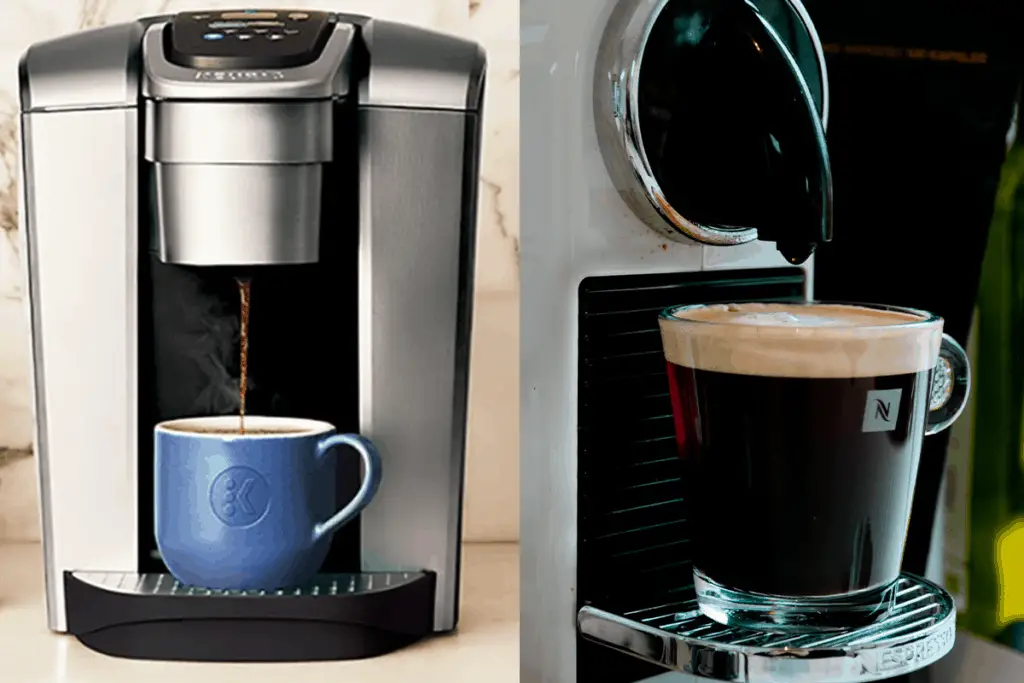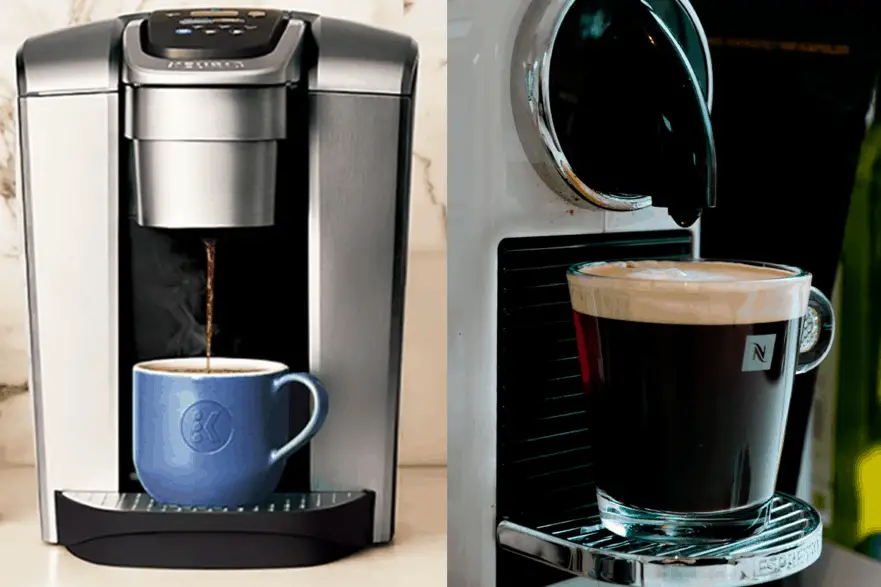
Single-serve coffee makers have transformed morning routines, delivering café-quality brews with the press of a button. With one in four American households owning a pod-based machine, Keurig and Nespresso dominate the market, each offering distinct experiences. Keurig’s K-Cup system prioritizes variety and affordability, while Nespresso’s aluminum capsules focus on premium espresso. Deciding between them depends on your coffee preferences, budget, and kitchen setup.
This guide compares their origins, brewing technology, drink options, design, environmental impact, and costs to help you choose the perfect machine for your home coffee bar.
A Brief History of Keurig and Nespresso
Nespresso, a Switzerland-based subsidiary of Nestlé, pioneered single-serve coffee in 1986. Renowned in Europe for its espresso machines, it entered the North American market with models tailored to larger coffee servings.
Keurig, part of Keurig Dr Pepper, emerged in the U.S. in the early 1990s, launching home-use machines in 2004. As the leading single-serve brand in America, Keurig appeals to those seeking convenience and diverse drink options. Understanding their roots sets the stage for exploring how each brand crafts its coffee experience.
Brewing Technology: How They Make Your Coffee
Nespresso and Keurig use different methods to brew coffee, impacting flavor and drink style. Nespresso’s VertuoLine machines employ Centrifusion technology, spinning aluminum capsules at 7,000 RPM to blend water and coffee grounds, creating a rich crema. Each capsule has a barcode that the machine scans to adjust temperature, brew time, and water volume for optimal results. This high-pressure system, delivering up to 19 bars, excels at producing espresso and espresso-based drinks with a robust flavor profile.
Keurig machines, by contrast, function like a drip coffee maker. They pierce nitrogen-sealed plastic K-Cups and force hot water through a filter, brewing coffee in seconds. Newer models use MultiStream technology, with multiple water streams to enhance extraction, but the lower pressure results in a lighter, drip-style coffee. While Keurig’s simplicity ensures speed, it doesn’t match Nespresso’s intensity, making it better suited for casual coffee drinkers.
Drink Options and Variety
Nespresso focuses on quality over quantity, offering 17 capsule varieties in its VertuoLine, including single-origin blends like Ethiopian Bukeela and Colombian Rosabaya, plus flavored and seasonal options. These capsules cater to espresso lovers, producing drinks like espresso, double espresso, gran lungo, and larger coffees. Some models include milk frothers for lattes and cappuccinos, but the selection is limited to Nespresso’s proprietary pods, available primarily through their website or boutiques.
Keurig shines in versatility, partnering with over 75 brands, including Starbucks, Dunkin’, and Green Mountain, to offer more than 400 K-Cup varieties. Beyond coffee, you can brew tea, hot chocolate, apple cider, and even soup. Keurig’s universal K-Cup compatibility allows third-party pods and reusable filters, letting you use your own grounds. This makes Keurig ideal for households with varied tastes or offices where everyone wants something different.
Cup Sizes and Capacity
Nespresso VertuoLine machines offer five cup sizes: espresso (1.35 oz), double espresso (2.7 oz), gran lungo (5 oz), coffee (8 oz), and alto (14 oz), suitable for travel mugs. Their 40-ounce water tanks support about five to seven brews before refilling.
Keurig machines provide four size options: 6, 8, 10, and 12 ounces, with larger 52-ounce tanks that can brew up to nine cups. Keurig’s larger capacity reduces refills, a plus for frequent brewers, while Nespresso’s range caters to both espresso and coffee drinkers.
Design and Features
Nespresso machines, built with partners like Breville and De’Longhi, boast sleek, European-inspired designs that elevate kitchen aesthetics. VertuoLine models are compact, intuitive, and often include features like automatic capsule ejection and milk frothers. Their quiet operation and energy-efficient auto-off settings enhance user experience. However, they require proprietary pods, limiting flexibility.
Keurig machines prioritize functionality over style, with larger footprints due to bigger reservoirs. Models like the K-Select offer features like Quiet Brew Technology, Strong Brew mode for bolder coffee, and fingerprint-resistant finishes. While less elegant, Keurig’s user-friendly interfaces and customization options, like brew strength and temperature settings on premium models, appeal to those who value practicality. Their compatibility with reusable filters adds versatility for eco-conscious users.
Environmental Impact
Sustainability is a key consideration for pod-based coffee makers, as capsules contribute to significant waste—approximately 576,000 metric tons annually, with 29,000 of 39,000 capsules produced each minute ending in landfills. Nespresso addresses this through its recycling program, using aluminum capsules that are recyclable via free mail-back bags or drop-off points at boutiques and UPS locations. The Vertuo Next machine incorporates over 50% recycled plastic, and Nespresso’s sustainability initiatives include sourcing coffee responsibly.
Keurig has faced criticism for its plastic K-Cups, which are challenging to recycle due to their composite materials. Since 2020, Keurig has transitioned to recyclable polypropylene (#5 plastic) pods, but recycling requires peeling off the foil lid, emptying grounds, and checking local recycling capabilities. Keurig’s K-Round pods, introduced in 2024, are plastic-free and compostable but require the new Alta system, which isn’t widely available yet. Reusable K-Cup filters offer a waste-free alternative, though they add manual effort.
Price Comparison
Nespresso VertuoLine machines range from $130 for the Vertuo Pop+ to $700 for high-end models like the Creatista Pro, with frequent discounts bringing entry-level units to around $100. Capsules cost $0.90 to $1.35 each, averaging $11 per sleeve, making daily use pricier.
Keurig machines are more budget-friendly, retailing from $60 for the K-Mini to $230 for the K-Duo Plus, often discounted to $50 during sales. K-Cups range from $0.35 to $0.65 per pod, with boxes of 12 starting at $5. Reusable filters can further reduce costs by allowing bulk ground coffee purchases.
| Feature | Nespresso VertuoLine | Keurig |
|---|---|---|
| Price Range (Machine) | $130–$700 | $60–$230 |
| Pod Cost (Per Serving) | $0.90–$1.35 | $0.35–$0.65 |
| Drink Types | Espresso, coffee, latte, cappuccino | Coffee, tea, hot chocolate, cider, soup |
| Pod Variety | 17 (Nespresso only) | 400+ (75+ brands) |
| Cup Sizes | 1.35, 2.7, 5, 8, 14 oz | 6, 8, 10, 12 oz |
| Water Tank | 40 oz | 52 oz |
| Recycling | Aluminum, mail-back program | Plastic, limited recycling; reusable filters |
| Durability | 5–10 years | 3–5 years |
Coffee Quality and Taste
Nespresso’s high-pressure brewing and curated capsules deliver a richer, more aromatic coffee, often compared to café-quality espresso. Its dark roasts and crema-heavy brews appeal to those who savor bold flavors, though some find them bitter due to the coffee-to-water ratio.
Keurig’s drip-style coffee tends to be weaker and less nuanced, with a reputation for bitterness at larger sizes. The Strong Brew setting helps, but professional reviews consistently rate Nespresso higher for taste. Keurig’s strength lies in its vast flavor options, catering to diverse palates.
Durability and Maintenance
Nespresso machines are built to last, often enduring 5–10 years with proper care, thanks to stainless steel components and partnerships with premium manufacturers. Keurig machines typically last 3–5 years, with some users reporting issues like pump failures. Both require regular cleaning to prevent scale buildup, with Nespresso’s descaling process being simpler due to its compact design. Keurig’s milk frothers, found on models like the K-Cafe, demand extra cleaning but are dishwasher-safe.
Which Should You Choose?
Choosing between Keurig and Nespresso hinges on your coffee habits and priorities. Nespresso is the go-to for espresso enthusiasts who value rich, high-quality brews and don’t mind paying a premium. Its sleek design, durable build, and recycling program make it ideal for those seeking a refined coffee experience with a nod to sustainability. Opt for Nespresso if you love espresso, lattes, or cappuccinos and want a machine that looks as good as it performs.
Keurig suits budget-conscious coffee drinkers who prioritize variety and convenience. With affordable machines, widely available pods, and options for tea, hot chocolate, or even soup, it’s perfect for households with diverse tastes or offices where simplicity reigns. Reusable filters make it more eco-friendly, and its larger water tank supports frequent brewing. If espresso isn’t your thing, Keurig’s versatility is hard to beat.
Both brands deliver the convenience of single-serve coffee, but Nespresso excels in quality, while Keurig wins on affordability and variety. Consider your daily coffee routine, kitchen space, and environmental values to find the machine that’ll keep your mornings brewing smoothly.

